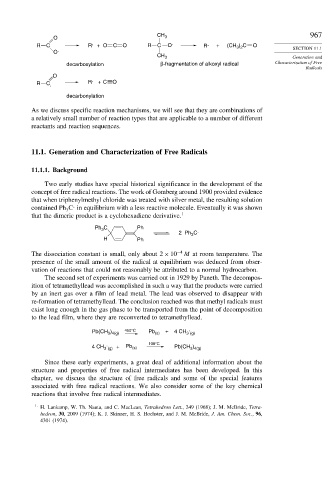Page 983 - Advanced Organic Chemistry Part A - Structure and Mechanisms, 5th ed (2007) - Carey _ Sundberg
P. 983
967
O CH 3
.
R C R + O C O R C O . R . + (CH 3 2 O SECTION 11.1
) C
O .
CH 3 Generation and
decarboxylation β-fragmentation of alkoxyl radical Characterization of Free
Radicals
O
R C . R . +C O
decarbonylation
As we discuss specific reaction mechanisms, we will see that they are combinations of
a relatively small number of reaction types that are applicable to a number of different
reactants and reaction sequences.
11.1. Generation and Characterization of Free Radicals
11.1.1. Background
Two early studies have special historical significance in the development of the
concept of free radical reactions. The work of Gomberg around 1900 provided evidence
that when triphenylmethyl chloride was treated with silver metal, the resulting solution
contained Ph C in equilibrium with a less reactive molecule. Eventually it was shown
3
that the dimeric product is a cyclohexadiene derivative. 1
Ph C Ph .
3
2 Ph 3 C
H Ph
The dissociation constant is small, only about 2 × 10 −4 M at room temperature. The
presence of the small amount of the radical at equilibrium was deduced from obser-
vation of reactions that could not reasonably be attributed to a normal hydrocarbon.
The second set of experiments was carried out in 1929 by Paneth. The decompos-
ition of tetramethyllead was accomplished in such a way that the products were carried
by an inert gas over a film of lead metal. The lead was observed to disappear with
re-formation of tetramethyllead. The conclusion reached was that methyl radicals must
exist long enough in the gas phase to be transported from the point of decomposition
to the lead film, where they are reconverted to tetramethyllead.
.
Pb(CH ) 450°C Pb (s) + 4 CH 3 (g)
3 4(g)
.
4 CH 3 (g) + Pb (s) 100°C Pb(CH )
3 4(g)
Since these early experiments, a great deal of additional information about the
structure and properties of free radical intermediates has been developed. In this
chapter, we discuss the structure of free radicals and some of the special features
associated with free radical reactions. We also consider some of the key chemical
reactions that involve free radical intermediates.
1
H. Lankamp, W. Th. Nauta, and C. MacLean, Tetrahedron Lett., 249 (1968); J. M. McBride, Tetra-
hedron, 30, 2009 (1974); K. J. Skinner, H. S. Hochster, and J. M. McBride, J. Am. Chem. Soc., 96,
4301 (1974).

